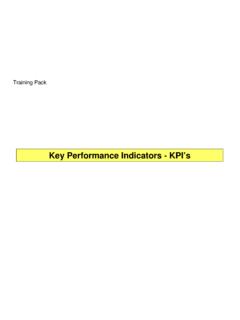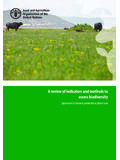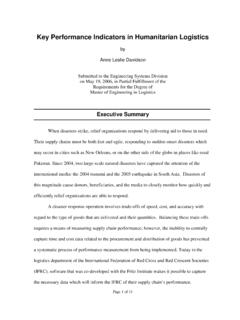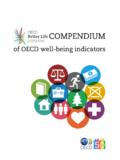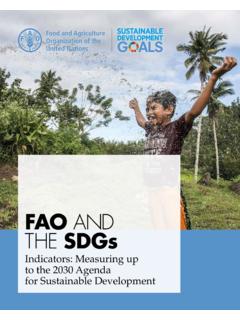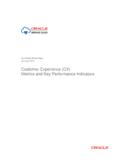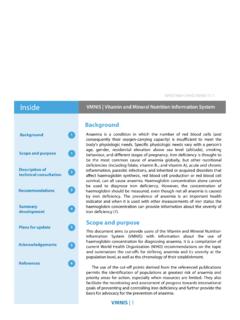Transcription of Using Leading Indicators to Forecast Demand
1 1 | P a g e Using Leading Indicators to Forecast Demand What the present can tell us about the future Predicting Demand can be one of the most challenging activities an organization undertakes, but organizations that have a better handle on the future will on average outperform those who do not. Better performance is achieved through improved matching of supply with Demand , more effective inventory control, and the ability to grow or contract with market conditions. Organizations looking for a more analytic approach to forecasting and planning revenue should consider employing Leading Indicators as a method to improve insight into future performance. Overview of Leading Indicators Leading Indicators are events or measures that are a prelude to, and can thus help predict, another event or measure.
2 If you have ever experienced a thunderstorm you know that a bolt of lightning always precedes a clap of thunder. Thunder is the sound made by lightning, but due to the relative speeds of light and sound, lightning is a Leading indicator of thunder. This relationship is a good analogy for how Leading Indicators are useful in business. Many underlying economic conditions move through value chains and geographies at different speeds. Understanding and measuring the fastest moving conditions will give you better insight into those measures that are important to you, but do not move at the same rates. As an example, large computer hardware manufacturers such as IBM and HP are keenly interested in monthly measures of corporate IT spending, as these serve as Indicators for how much hardware they will sell in future periods.
3 There are two different types of Leading Indicators that organizations typically monitor. External Leading Indicators help predict exogenous, environmental impacts to Demand . These are the factors that lead to the saying a rising tide lifts all boats , or as we saw in late 2008, force boats to take dramatic measures to avoid being run aground. External Indicators can measure broad economic activity, such as employment or gross domestic product, or specific industry activity such as manufacturing output or housing starts. Internal Leading Indicators are company specific measures that provide insight into how Demand for a specific product or basket of products may behave over the near term. These Indicators are typically market facing and may include customer satisfaction, results of focus groups, and level of returns.
4 Since each measure helps predict something different, it is important that organizations consider building a mix of both internal and external Leading Indicators into their planning approach. Choosing the Best Leading Indicators Two factors influence the quality of Leading Indicators : the degree to which an indicator predicts the outcome that is trying to be measured, and the availability of a high quality Forecast of the indicator . Finding Indicators that meet both criteria can produce a predictive approach that provides up to 12 months of insight to an organization s Demand . 2 | P a g e Criteria 1: How Leading is the indicator ? The best Leading Indicators have a timing lag of up to six months before the results are evident in the dependent (or lagging) variable. The best way to test this criteria is to perform regression analysis on historical data for both the Leading indicator and the dependent variable, with time lags of 1 month, 3 months, and 6 months built into the data sets.
5 The time lag with the highest correlation is usually the period of lag between the Leading indicator and the dependent variable. Leading Indicators with a long time lag and high correlation to the dependent variable will be most relevant to an organization. Criteria 2: Is a Forecast Available? Many external Indicators are available not only as historical data, but also as predicted, future values. When a Forecast for an indicator is available, it extends the time horizon for which a dependent variable can be predicted. For example, if an external indicator is available with a 6-month Forecast and has a 6-month positively correlated time lag, an organization could predict the dependent variable for up to 12 months in the future. It is important to note that many public sources exist for external Indicators , and subscription services for less common Indicators are available for a fee.
6 If possible, finding data and forecasts for each indicator from multiple sources will yield the highest quality consensus figure. A Framework for Evaluating Leading Indicators Once an organization has identified a Leading indicator that has a strong correlation to a key dependent variable, it is possible to evaluate the quality of the indicator Using a two by two matrix. The horizontal dimension measures the degree to which Indicators are truly Leading (both from a time lag and the degree of correlation). The vertical dimension measures the extent to which a quality Forecast is available for the indicator . Quadrant 1: Indicators that fall into this quadrant are useful to explain what occurred in the past, and why, but are not useful for a predictive approach to planning. TimeDependent VariableLeading IndicatorTimeDependent VariableLeading IndicatorCriteria 1: Leading indicator Criteria 2: Forecast Available 3 | P a g e Quadrant 2: Indicators in this quadrant are not Leading , but can help predict future outcomes based on the duration and quality of the Forecast .
7 Quadrant 3: Indicators that fall into this quadrant can be quite valuable, especially if the time lag is 3-6 months and the correlation is significant; these Indicators are more valuable than those in Quadrant 2 because dependent variable predictions are based on actual data rather than a Forecast . Quadrant 4: Indicators that are both Leading and have a quality Forecast available are optimal and can allow up to 12 months of predicted Demand may be available ( , combining a 6 month lag with a 6 month Forecast ) A planning approach that leverages Leading Indicators analysis will position organizations to identify changes in internal and external factors that directly impact Demand and sales. At a minimum, Leading Indicators should help management identify inflection points to allow organizations to take better advantage of growth cycles (thus increasing shareholder value) and in a downturn, push the brake pedal at the right time to avoid destroying more shareholder value than necessary.
8 For more information contact: Ted Schneider Principal Brian Leslie Principal Leading indicatorForecast AvailableTime correlatedHistorical InformationValuable for duration of lagInteresting, but not usefulValuable for duration of forecastMost valuable for longest durationNature of correlationData AvailabilitySwitchPoint Leading indicator Framework4321 Figure 1: SwitchPoint Leading indicator Framework
